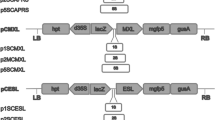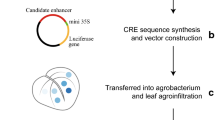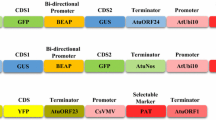Abstract
Enhancer-promoter interactions have the potential to compromise the precise engineering of gene function and agronomically important traits in crops; therefore, effective enhancer-blocking insulators are required in transgene constructs to block such interference. In this study, we evaluated and compared the insulation efficiency of three enhancer-blocking insulators using an enhancer activation assay in which a flower-specific AGAMOUS second intron-derived promoter (AGIP) that drives a β-glucuronidase (GUS) reporter gene is activated in vegetative tissues by an adjacent CaMV35S enhancer. Of the insulators analyzed, both the EXOB fragment from the lambda genome and the TBS from petunia were found to effectively block enhancer activation, while the 16 bp NI29 fragment from Arabidopsis inserted either as a single copy or tandem repeat in the same assay vector failed to do the same as revealed by the detection of strong GUS expression in the leaves. PCR amplification and DNA sequencing analyses demonstrated that there were no deletions or mutation events within the transgenic NI29 sequence, indicating that the failure of NI29 to block 35S enhancer activation was not the result of gene rearrangements or sequence mutations. Quantitative analysis of GUS reporter expression at both the enzymatic and transcriptional levels exemplified that the EXOB is on average four times more efficient than the TBS in blocking enhancer-promoter communication. This highly effective insulator has an immediate application for remedying enhancer-promoter interactions within transformation vectors composed of multiple transcription units.




Similar content being viewed by others
References
Barges S, Mihaly J, Galloni M, Hagstrom K, Muller M, Shanower G, Schedl P, Gyurkovics H, Karch F (2000) The Fab-8 boundary defines the distal limit of the bithorax complex iab-7 domain and insulates iab-7 from initiation elements and a PRE in the adjacent iab-8 domain. Development 127:779–790
Barski A, Cuddapah S, Cui K, Roh TY, Schones DE, Wang Z, Wei G, Chepelev I, Zhao K (2007) High-resolution profiling of histone methylations in the human genome. Cell 129:823–837
Belostotsky DA, Meagher RB (1996) A pollen-, ovule-, and early embryo-specific poly(A) binding protein from Arabidopsis complements essential functions in yeast. Plant Cell 8:1261–1275
Benfey PN, Ren L, Chua NH (1989) The CaMV35S enhancer contains at least two domains which can confer different developmental and tissue-specific expression patterns. EMBO J 8:2195–2202
Benfey PN, Ren L, Chua NH (1990) Tissue-specific expression from CaMV35S enhancer subdomains in early stages of plant development. EMBO J 9:1677–1684
Bevan M (1984) Agrobacterium vectors for plant transformation. Nucleic Acids Res 12:8711–8721
Capelson M, Corces VG (2005) The ubiquitin ligase dTopors directs the nuclear organization of a chromatin insulator. Mol Cell 20:105–116
Chung JH, Whiteley M, Felsenfeld G (1993) A 5′ element of the chicken β-globin domain serves as an insulator in human erythroid cells and protects against position effect in Drosophila. Cell 74:505–514
Clough SJ, Bent AF (1998) Floral dip: a simplified method for Agrobacterium-mediated transformation of Arabidopsis thaliana. Plant J 16:735–743
Filippova GN, Fagerlie S, Klenova EM, Myers C, Dehner Y, Goodwin G, Neiman PE, Collins SJ, Lobanenkov VV (1996) An exceptionally conserved transcriptional repressor, CTCF, employs different combinations of zinc fingers to bind diverged promoter sequences of avian and mammalian c-myc oncogenes. Mol Cell Biol 16:2802–2813
Gan S, Xie M (2002) Genetic insulator for preventing influence by another gene promoter. USA patent # 20060174370
Gaszner M, Felsenfeld G (2006) Insulators: exploiting transcriptional and epigenetic mechanisms. Nat Rev Genet 7:703–713
Gaszner M, Vazquez J, Schedl P (1999) The Zw5 protein, a component of the scs chromatin domain boundary is able to block enhancer-promoter interaction. Genes Dev 13:2098–2107
Georgiev PG, Gerasimova TI (1989) Novel genes influencing the expression of the yellow locus and mdg4 (gypsy) in Drosophila melanogaster. Mol Gen Genet 220:121–126
Gudynaite-Savitch L, Johnson DA, Miki BLA (2009) Strategies to mitigate transgene-promoter interactions. Plant Biotechnol J 7:472–485
Gustinich S, Manfioletti G, del Dal G, Schneider C (1991) A fast method for high quality genomic DNA extraction from whole human blood. BioTechniques 11:298–302
Hily JM, Liu Z (2009) A simple and sensitive high-throughput GFP screening in woody and herbaceous plants. Plant Cell Rep 28:493–501
Hily J-M, Singer SD, Yang Y, Liu Z (2009) A transformation booster sequence (TBS) from Petunia hybrida functions as an enhancer-blocking in Arabidopsis thaliana. Plant Cell Rep 28:1095–1104
Hirner B, Fischer WN, Rentsch D, Kwart M, Frommer WB (1998) Developmental control of H+/amino acid permease gene expression during seed development of Arabidopsis. Plant J 14:535–544
Jagannath A, Bandyopadhyay P, Arumugam N, Gupta V, Kumar P, Pental D (2001) The use of a Spacer DNA fragment insulates the tissue-specific expression of a cytotoxic gene (barnase) and allow high-frequency generation of transgenic male sterile lines in Brassica juncea L. Mol Breeding 8:11–23
Jefferson R (1988) Plant reporter genes: the GUS gene fusion system. In: Setlow JK, Hollaender A (eds) Genetic engineering: principles, methods. Plenum Press, New York, pp 247–263
Karch F, Galloni M, Sipos L, Gausz J, Gyurkovics H, Shedl P (1994) Mcp and Fab-7: molecular analysis of putative boundaries of cis-regulatory domains in the bithorax complex of Drosophila melanogaster. Nucleic Acids Res 22:3138–3146
Kay R, Chan A, Daly M, McPherson J (1987) Duplication of CaMV35S promoter sequences creates a strong enhancer for plant genes. Science 236:1299–1302
Kim T, Abdullaev Z, Smith A, Ching K, Loukinov D, Green R, Zhang M, Lobanenkov V, Ren B (2007) Analysis of the vertebrate insulator protein CTCF-binding sites in the human genome. Cell 128:1231–1245
Koltunow AM, Truettner J, Cox KH, Wallroth M, Goldberg RB (1990) Different temporal and spatial gene expression patterns occur during anther development. Plant Cell 2:1201–1224
Lee WS, Tzen JTC, Kridl JC, Radke SE, Huang AHC (1991) Maize oleosin is correctly targeted to seed oil bodies in Brassica napus transformed with the maize oleosin gene. Proc Natl Acad Aci USA 88:6181–6185
Liu Z, Liu Z (2008) The second intron of AGAMOUS drives carpel- and stamen-specific expression sufficient to induce complete sterility in Arabidopsis. Plant Cell Rep 27:855–863
Liu Z, Zhou C, Wu K (2008) Creation and analysis of a novel chimeric promoter for the complete containment of pollen- and seed-mediated gene flow. Plant Cell Rep 27:995–1004
Modolell J, Bender W, Meselson M (1983) Drosophila melanogaster mutations suppressible by the suppressor of Hairy-wing are insertions of a 7.3-kilobase mobile element. Proc Natl Acad Sci USA 80:1678–1682
Moon H, Filippova G, Loukinov D, Pugacheva E, Chen Q, Smith ST, Munhall A, Grewe B, Bartkuhn M, Arnold R, Burke LJ, Renkawitz-Pohl R, Ohlsson R, Zhou J, Renkawitz R, Lobanenkov V (2005) CTCF is conserved from Drosophila to humans and confers enhancer blocking of the Fab-8 insulator. EMBO Rep 6:165–170
Nagaya SN, Yoshida K, Kato K, Akasaka K (2001) An insulator element from the sea urchin Hemicentrotus pulcherrimus suppresses bariation in transgene expression in cultured tobacco cells. Mol Genet Genom 265:405–413
Namciu SJ, Blochlinger KB, Fournier REK (1998) Human matrix attachment regions insulate transgene expression from chromosomal position effects in Drosophila melanogaster. Mol Cell Biol 18:2382–2391
Ni M, Cui D, Einstein J, Narasimhulu S, Vergara CE, Gelvin SB (1995) Strength and tissue specificity of chimeric promoters derived from the octopine and mannopine synthase genes. Plant J 7:661–676
Odell JT, Knowlton S, Lin W, Mauvais J (1988) Properties of an isolated transcription stimulating sequence derived from the cauliflower mosaic virus 35S promoter. Plant Mol Biol 10:263–272
Ohlsson R, Renkawitz R, Lobanenkov V (2001) CTCF is a uniquely versatile transcription regulator linked to epigenetics and disease. Trends Genet 17:520–527
Savidge B, Rounsley SD, Yanofsky MF (1995) Temporal relationship between the transcription of two Arabidopsis MADS box genes and the floral organ identity genes. Plant Cell 7:721–733
Singer SD, Hily J-M, Liu Z (2010) A 1 kb bacteriophage lambda fragment functions as an insulator to effectively block enhancer-promoter interactions in Arabidopsis thaliana. Plant Mol Biol Rep 28:69–76
Smith DL, Fedoroff NV (1995) LRP1, a gene expressed in lateral and adventitious root primordia of Arabidopsis. Plant Cell 7:735–745
Steinwaerder DS, Lieber A (2000) Insulation from viral transcriptional regulatory elements improves inducible transgene expression from adenovirus vectors in vitro and in vivo. Gene Ther 7:556–567
Wallace JA, Felsenfeld G (2007) We gather together: insulators and genome organization. Curr Opin Genet Dev 17:400–407
Ye X, Liang M, Meng X, Ren X, Chen H, Li ZY, Ni S, Lieber A, Hu F (2003) Insulation from viral transcriptional regulatory elements enables improvement to hepatoma-specific gene expression from adenovirus vectors. Biochem Biophys Res Commun 307:759–764
Yoo SY, Bomblies K, Yoo SK, Yang JW, Choi MS, Lee JS, Weigel D, Ahn JH (2005) The 35S promoter used in a selectable marker gene of a plant transformation vector affects the expression of the transgene. Planta 221:523–530
Zhao K, Hart CM, Laemmli UK (1995) Visualization of chromosomal domains with boundary element associated factor BEAF-32. Cell 81:879–889
Zheng X, Deng W, Luo K, Duan H, Chen Y, McAvoy R, Song S, Pei Y, Li Y (2007) The cauliflower mosaic virus (CaMV) 35S promoter sequence alters the level and patterns of activity of adjacent tissue- and organ-specific gene promoters. Plant Cell Rep 26:1195–1203
Zhou J, Ashe H, Burks C, Levine M (1999) Characterization of the transvection mediating region of the abdominal-B locus in Drosophila. Development 126:3057–3065
Acknowledgments
We would like to thank Mr. Dennis Bennett for his excellent technical assistance. This study was funded by the United States Department of Agriculture (USDA)—Agricultural Research Service Headquarter 2007 classes of postdoctoral grants and the Biotechnology Risk Assessment Program Grant (2006-03701) from the USDA National Institute of Food and Agriculture.
Author information
Authors and Affiliations
Corresponding author
Rights and permissions
About this article
Cite this article
Yang, Y., Singer, S.D. & Liu, Z. Evaluation and comparison of the insulation efficiency of three enhancer-blocking insulators in plants. Plant Cell Tiss Organ Cult 105, 405–414 (2011). https://doi.org/10.1007/s11240-010-9880-8
Received:
Accepted:
Published:
Issue Date:
DOI: https://doi.org/10.1007/s11240-010-9880-8




